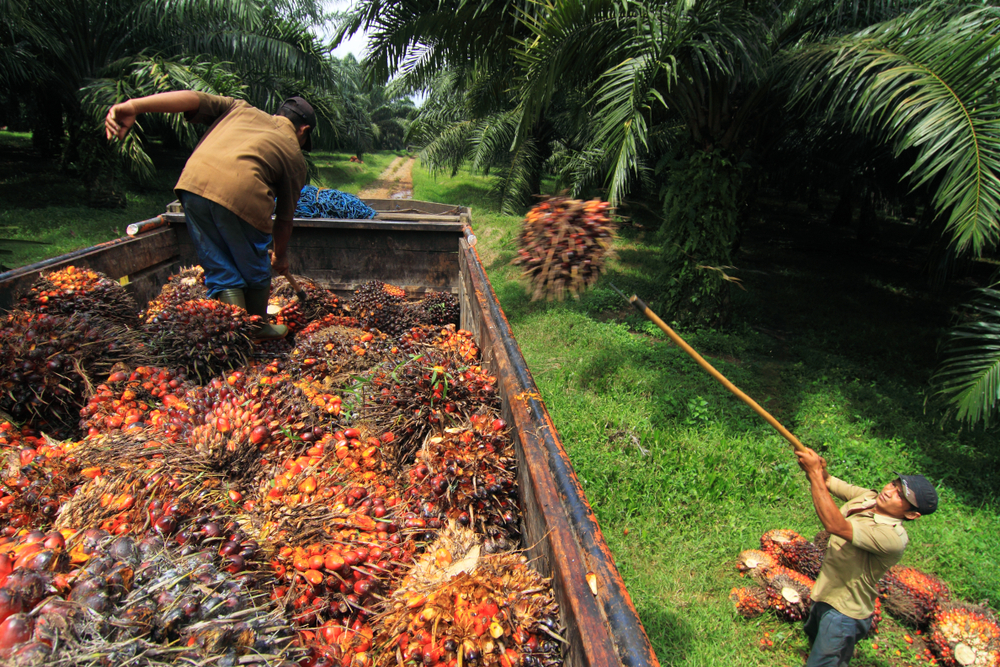Palm oil has a poor image. Countless food and cosmetic products now market themselves explicitly as ‘palm oil free’. But is the hype correct? A new Wageningen study shows that palm oil does not deserve its bad-guy reputation. Or to be more precise, it doesn’t always deserve that reputation.
The sound of chainsaws felling trees and the wails of orang-utans — that is the impression associated in people’s minds with palm oil. Our insatiable demand for oils and fats, which led us to decimate various whale species in the previous century, is still having a negative impact on nature and biodiversity in the new millennium.
Producers of cosmetics and food products are happy to exploit the discomfort we feel on seeing those pictures of tropical jungle being destroyed, and ‘palm oil free’ has become a familiar slogan on product labels. But it turns out that the alternatives, such as oil from rapeseed, soya or coconut, are not necessarily any better.
Less deforestation, but not zero
‘I definitely think the concerns were — and still are — justified to some extent,’ says Wolter Elbersen, WUR researcher in Biorefinery & Fibre Technology. ‘Deforestation due to palm oil in Malaysia and Indonesia was a major problem. That is less the case now but it is still not zero. At the same time, the cultivation of oil palms has a lot of advantages, while innovations are making it more sustainable.’
Elbersen travelled to Borneo and Sumatra and has previously visited Malaysia. In a project commissioned by the Ministry of Foreign Affairs and carried out with colleagues from WUR, Van Hall Larenstein University of Applied Sciences and IPB University in Bogor (Indonesia), he looked at the sustainability of three types of oil: palm oil from Indonesia, soya oil from Brazil and rapeseed oil from Germany.
The scientific findings are not black-and-white, but palm oil does indeed turn out to be the most sustainable in some respects. Let’s start with the production per hectare. According to Elbersen, an oil palm plantation produces more than twice as much oil per hectare as a hectare of soya or rapeseed. ‘And it still outperforms the other crops in terms of efficiency if you allow for the fact that soya, for example, is used not only for oil but also for the proteins in animal feed. And while the production of rapeseed per hectare in Europe has increased in recent years, the total yield of oil per hectare is far less than in the case of palm oil.’
Production can increase by half again
The scientists estimate that there is potential for the production of palm oil per hectare to increase by half again. That is important because higher production from existing plantations reduces the need to clear new land for oil palms, or another oil crop.
The study also mentions various other improvements farmers in Indonesia and Malaysia could make: better plantation maintenance, better use of fertilizer and nutrients, using the most productive varieties more, and replacing old trees sooner to keep the plantation’s production at a high level.
Finally, more can be done with an oil palm plantation than simply extracting the oil. Elbersen: ‘You could grow other crops such as maize or melons in amongst the oil palms during the first three years, when the palms are too small to produce any oil.’
Biodiesel and wood
The Wageningen scientist specializes in the search for ways of utilizing waste streams from palm oil plantations. ‘Biodiesel can be produced from the waste stream from palm oil production. Another option is to use palmwood for furniture.’
Palm oil cultivation scores much better than soya and rapeseed in another respect too: it provides more work (and income) for the local population. According to the study, palm oil generates more income per hectare than the two other oil crops because the cultivation is more labour-intensive. You therefore need fewer square metres to earn a minimum wage.
Elbersen: ‘That might not be what first springs to mind for consumers in the Netherlands but it is very important to countries such as Indonesia. Millions of smallholders have been able to earn a reasonable livelihood thanks to palm oil. And because palm oil is affordable, it is also an important source of calories for the poor in Asia and Africa. We have the luxury of being able to choose between different types of oil, but they don’t.’
Greenhouse gases: bringing up the rear
As regards the pollution caused by cultivation, all three oil crops score poorly. But from the perspective of climate change, palm oil is as yet in last place. Rapeseed oil does best. That is partly because some of the oil palm plantations are on peatland. And just like in the Netherlands, when the peatland is drained and settles, CO₂ escapes into the air. Furthermore, rotting waste products lead to emissions of methane, an even stronger greenhouse gas. Even so, the scientists think palm oil can catch up with soya and rapeseed in its climate performance. One way to do that is to tackle the waste streams. But that won’t happen of its own accord. ‘The political will is needed to make it happen,’ says Elbersen. It remains to be seen whether that message has hit home. The results of the study have now been shared with both the Dutch and Indonesian governments.
Abuses: a problem, even if not taken into account
Wolter Elbersen and his colleagues compared Indonesian palm oil, German rapeseed oil and Brazilian soya oil from the point of view of the UN’s sustainable development goals (SDGs), looking at the period to 2040. Notorious abuses in the cultivation of oil palms and soya, such as land grabs and human rights abuses, were not taken into account — but they are definitely a problem, says Elbersen. ‘This research project focused on things that can easily be quantified,’ he explains. ‘We are researchers, not journalists. It’s hard for us to work out what is going on illegally, let alone quantify it.’
What can be quantified is the income effect. That shows that palm oil is not necessarily the bad guy not only in terms of its effect on nature and the environment — Wageningen research had already suggested that in the past — but also that palm oil generates a substantially higher income per hectare than the other two oil crops. ‘Here in Europe, we often forget that aspect: palm oil has brought about an amazing improvement in prosperity, especially in rural areas. That makes it an important crop in those countries that is often highly appreciated by the community,’ says Elbersen.
In addition to the economic impact and the effects on biodiversity, the researchers considered four other criteria in assessing the three oil crops against the SDGs: land use, greenhouse gas emissions, pollution and a secure livelihood. The research was commissioned by the Ministry of Foreign Affairs and the report can be found online. ME
This article previously appeared in De Gelderlander/Edwin Timmer; the Resource editors added the box text.

 Men at work on a palm oil plantation in Indonesia. Photo Shutterstock
Men at work on a palm oil plantation in Indonesia. Photo Shutterstock